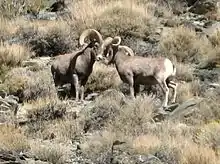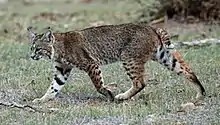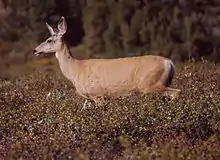Sierra de San Pedro Mártir National Park
Sierra de San Pedro Mártir National Park is a national park in the Mexican state of Baja California. The Park is part of the municipality of Ensenada, Baja California. The area was first explored by Europeans in 1701 by Eusebio Francisco Kino by Dominican orders.
| Sierra de San Pedro Mártir National Park | |
|---|---|
IUCN category II (national park) | |
 | |
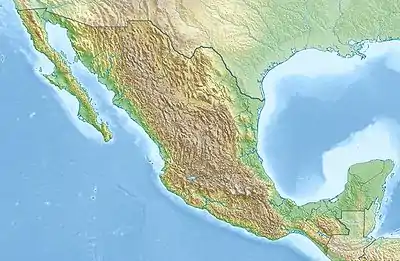 | |
| Location | Ensenada Municipality, Mexicali Municipality, Baja California, Mexico |
| Nearest city | San Felipe, Baja California |
| Coordinates | 30°54′19″N 115°30′04″W |
| Area | 72,909 hectares (180,160 acres) |
| Established | April 26, 1947 [1] |
| Governing body | Secretariat of the Environment and Natural Resources |
The park is known for its pine trees and granite rock formations. Sierra de San Pedro Mártir is a mountain range that runs north-south along the middle part of northwestern Baja California, Mexico. with its name Spanish for "mountains of Saint Peter the Martyr. Picacho del Diablo (Devil's Peak) is the highest peak in the park and in Baja California with its summit reaching 3,096 meters (10,157 feet). Sierra de San Pedro Mártir National Park is one of the few pine forests that exists on the Baja California peninsula that is important habitat for native Bighorn Sheep. In addition the park is home to the California condor through re-introduction program by several international agencies.
The National Astronomical Observatory, built in 1971 on a neighboring peak, Cerro del la Cúpula, is home to Mexico's largest optical telescope, with a diameter of 2.12 meters, and a weight of 40 tons in total. The observatory is the second most important in Latin America.
History
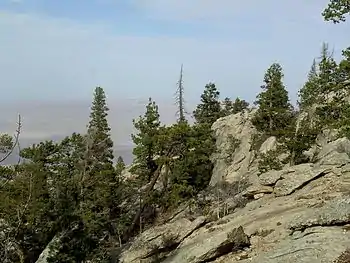
The first explorations of the region were realized by the Jesuit order during the evangelization era of the neo-Hispanic territories of California. The regions of the Sierra de San Pedro Mártir are thought to have been explored by father Eusebio Francisco Kino and father Wenceslao Link in 1701. Later the Dominicans continuing the evangelization movement built the Misión de San Pedro Mártir de Verona in the southern part of the park, but only ruins are left of the site.
Sierra de San Pedro Mártir National Park was officially created by decree on April 26, 1947, in which 72,909 hectares were set aside and declared protected by the Mexican Federal government.[1] The National Astronomical Observatory is located at an elevation of 2,830 m (9,280 ft). The observatory was built in 1975, and has several large telescopes, the largest of which is 2.1 m (83 in). The observatory takes advantage of the high elevation, along with typically clear skies, low relative humidity, low atmospheric pollution, low light pollution, and low levels of radio interference.
Geography
Sierra de San Pedro Mártir National Park is a national park located on the northern part of the Cordillera Baja California Mountain Range, known as Sierra de San Pedro Mártir.
The elevated peak is thought to have begun to rise in the Paleozoic era through tectonic rifts. Sierra de San Pedro Mártir a rugged mountain range with drastic topological changes covered with pine forest and surrounded by large deserts. Because it is surrounded by deserts, the park is often described as an oasis.[2]
Picacho del Diablo is the highest peak in the park measuring 3,096 meters (10,157 feet) above sea level. Picacho del Diablo is on the east side of the park. Throughout the park there are several deep canyons and many abrupt topological changes.
Climate
The Sierra de San Pedro Mártir Mountain Range has two main climates with an average annual temperature of 68 °F (20 °C). A Continental climate Dsa in the higher elevations and semiarid climate in the lower elevations. In the higher elevations the rainy season comes during the winter with 36% precipitation falling with frequent rainstorms and several snowstorms. During the summer in the higher elevations with 22.9% precipitation falling. Winters are mild with temperatures typically varying from 37 to 64 °F (3 to 18 °C). Summers are warm with temperatures varying from 64 to 90 °F (18 to 32 °C). Temperatures vary drastically throughout the park according to elevation due to dramatic topographical changes. During the winter in the extreme high elevations large amount of snow accumulates while in the summer the lower elevations exceed 100 °F (38 °C).[3]
| Month | Jan | Feb | Mar | Apr | May | Jun | Jul | Aug | Sep | Oct | Nov | Dec | Year |
|---|---|---|---|---|---|---|---|---|---|---|---|---|---|
| Record high °C (°F) | 12.8 (55.0) |
16.2 (61.2) |
13.5 (56.3) |
15.4 (59.7) |
19.1 (66.4) |
23.4 (74.1) |
23.3 (73.9) |
21.3 (70.3) |
20.5 (68.9) |
17.4 (63.3) |
13.7 (56.7) |
8.8 (47.8) |
23.4 (74.1) |
| Average high °C (°F) | 1.2 (34.2) |
3.4 (38.1) |
8.2 (46.8) |
10.3 (50.5) |
11.3 (52.3) |
18.5 (65.3) |
17.6 (63.7) |
19.3 (66.7) |
16.0 (60.8) |
13.2 (55.8) |
7.6 (45.7) |
1.0 (33.8) |
11.1 (52.0) |
| Daily mean °C (°F) | −1.8 (28.8) |
−0.3 (31.5) |
4.8 (40.6) |
6.6 (43.9) |
7.7 (45.9) |
14.9 (58.8) |
15.0 (59.0) |
16.6 (61.9) |
13.3 (55.9) |
10.2 (50.4) |
3.9 (39.0) |
−2.2 (28.0) |
7.8 (46.0) |
| Average low °C (°F) | −4.7 (23.5) |
−4.2 (24.4) |
1.3 (34.3) |
2.8 (37.0) |
4.1 (39.4) |
11.2 (52.2) |
12.3 (54.1) |
14.0 (57.2) |
10.6 (51.1) |
7.2 (45.0) |
0.2 (32.4) |
−5.4 (22.3) |
4.5 (40.1) |
| Record low °C (°F) | −9.2 (15.4) |
−16.6 (2.1) |
−10.3 (13.5) |
−10.7 (12.7) |
−5.3 (22.5) |
6.0 (42.8) |
8.2 (46.8) |
11.8 (53.2) |
6.0 (42.8) |
−3.4 (25.9) |
−9.4 (15.1) |
−9.8 (14.4) |
−16.6 (2.1) |
| Record low wind chill | −15.7 | −32 | −16.8 | −20.4 | −14 | 0.1 | — | — | 0.6 | −11.4 | −19.9 | −19.3 | −32 |
| Average precipitation mm (inches) | 80.7 (3.18) |
20.9 (0.82) |
53.9 (2.12) |
12.7 (0.50) |
7.4 (0.29) |
0.8 (0.03) |
37.1 (1.46) |
45.2 (1.78) |
23.9 (0.94) |
3.9 (0.15) |
41.2 (1.62) |
54.4 (2.14) |
382.1 (15.04) |
| Average precipitation days | 6.2 | 2.0 | 4.0 | 1.8 | 1.0 | 0.1 | 2.6 | 3.3 | 2.5 | 0.6 | 3.4 | 3.4 | 30.9 |
| Source: National Autonomous University of Mexico [4] | |||||||||||||
Flora and fauna
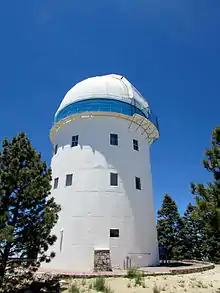
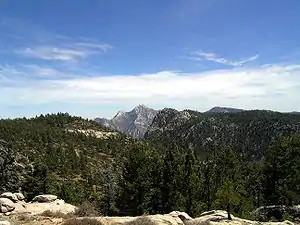
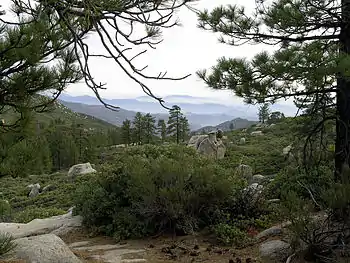

Sierra de San Pedro Mártir contains several coniferous species; the most abundant are: Pinus lambertiana, Pinus quadrifolia, Pinus jeffreyi, Abies concolor, and species of Cupressus [5] mostly found in the higher elevations. The flora is distinct from the flora of the rest of Mexico, and shares many species with the Laguna Mountains and San Jacinto Mountains in southwest California. The lower elevations of the Sierra de San Pedro Mártir are defined by chaparral and desert shrub. Sierra de San Pedro Mártir is a southern demarcation of the distribution of the California fan palm, Washingtonia filifera.[6]
Throughout the park there are a great variety of mammals: mule deer, bighorn sheep, cougar, bobcat, ringtail cat, coyote, rabbit, squirrel and more than 30 species of bats. The park is also home to many avian species like: bald eagle, golden eagle, falcon, woodpecker, black vulture, crow, several species of Sittidae. Captive-born California condor have been re-introduced to the wild in the Sierra San Pedro Martir, the first time they have been seen in the range since 1937. The condor was introduced into the park with international cooperation between the United States and Mexico. Local ecologists named the second generation of Californian condors "inyaa" (sun in the Kiliwa language).
Bibliography
Vargas Márquez, Fernando. 1984. Parques Nacionales de México y Reservas Equivalentes. Pasado, presente y futuro. Los Bosques de México. Instituto de Investigaciones Económicas. UNAM. México, D.F. 266 páginas.
References
- http://www.conanp.gob.mx/sig/?id=tw_redireccion
- "Sierra de San Pedro Mártir. Relevancia" Archived 2008-12-07 at the Wayback Machine. De la web de CONANP. Consultado el 3 de enero de 2009.
- "Archived copy". Archived from the original on 2011-07-22. Retrieved 2010-01-09.CS1 maint: archived copy as title (link)
- Observatorio Astronómico de San Pedro Mártir "Institute of Astronomy" (in Spanish). National Autonomous University of Mexico. Retrieved June 10, 2012.
- C. Michael Hogan. 2009. California Fan Palm: Washingtonia filifera Archived 2009-09-30 at the Wayback Machine GlobalTwitcher.com, ed. Nicklas Stromberg
| Wikimedia Commons has media related to Sierra de San Pedro Mártir National Park. |
